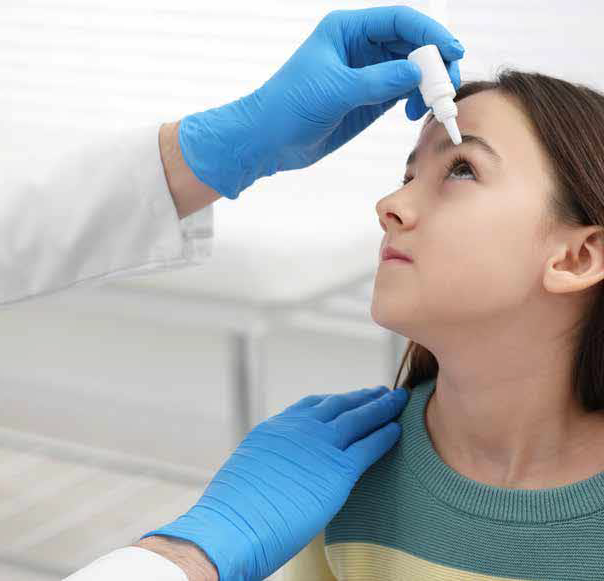
Atropine eye drops are a safe and effective way to mitigate childhood myopia, but efficacy depends on proper use.
Atropine eye drops are among three types of treatment options for childhood myopia, the other two being specially designed spectacles and contact lenses.
Although atropine eye drops have been used since the 1960s for the treatment of amblyopia (lazy eye) and in the past three decades for childhood myopia, there have been some concerns regarding the safety of this treatment option, especially with prolonged usage. A 2024 study by researchers at the Singapore National Eye Centre (SNEC) and Singapore Eye Research Institute (SERI) has shown that the long-term use of atropine eye drops is safe. The first-of-itskind study examined the longterm effects of these eye drops and found no complications arising in patients 10 to 20 years after treatment. There was also no association between those who had undergone atropine treatment and the increased incidence of treatment- or myopia-related ocular complications.
Side effects of atropine eye drops
Earlier studies have shown that, while high-dose atropine was safe and effective in reducing myopia progression, it caused side effects such as glare and blurring for reading and near work, said Dr Loh Kai Lyn, Consultant, Myopia Centre, SNEC. But these side effects can be mitigated by using photochromic and progressive lenses, she added.
A subsequent study showed that lowdose atropine was an effective alternative to high-dose atropine, leading to much reduced side effects.
Dr Loh shared that low-dose atropine is more commonly prescribed nowadays. “Most of the time, when we start with low-dose atropine, the child should be able to cope well. If they should have glare issues, they can use headgear or clip-on sunglasses while out in the sun, or have photochromic or tinted glasses. For reading issues, they can use progressive glasses to help them read well,” she said.
Importance of follow-ups
The effectiveness of atropine eyedrops in managing childhood myopia also hinges on its proper and consistent use.
“One of the most common issues we come across is patients not adhering to regular use of the drops. If eye drops are not used as frequently as prescribed, the effect may be suboptimal. This is especially true for the low-dose range. We try to engage patients and their caregivers to see what the underlying issue is, and give tips or alternatives as appropriate,” said Dr Loh.
Patients should also continue with their long-term follow-up appointments so that doctors can evaluate the appropriateness of the treatment. “Unlike a short course of antibiotics, atropine eye drops should be used as long as they are still effective in reducing myopia progression,” advised Dr Loh. “This usually means that they should be continued till the patient’s myopia naturally stops progressing, meaning the eyeball itself stops growing, which usually occurs around 13 to 15 years of age.”
Other treatment options
Other treatment options to curb the progression of childhood myopia include specially designed myopia-control spectacle lenses, such as the ones using defocus incorporated multiple segments (DIMS) technology, or contact lenses with highly aspherical lenslets target (HALT) technology. Contact lenses, such as daily disposable multifocal soft lenses (used in the day) or orthokeratology (OK) rigid lenses that are used at night, may also be prescribed. These alternative treatment options can be used in conjunction with atropine eye drops to provide a more optimal response in some patients, said Dr Loh.
However, she warned that parents should be wary of other treatments touted as myopia-control options. “It is important that parents educate themselves on separating those that have legitimate effects from those that have no effect or, worse, may cause increased myopia progression.” Dr Loh recommends that parents bring their children for an evaluation with their eye care practitioner to get customised treatments.
Treatments of the future
There may soon be more options available when it comes to the treatment of myopia in children.
One of them is the Repeated Low Level Red Light (RLRL) treatment. “RLRL is a new form of myopia control treatment that started in China and has shown good results in terms of efficacy,” said Dr Loh. “It requires patients to have a device at home and receive therapy for three minutes at a time, twice daily. In contrast to myopia control glasses or contact lenses, RLRL, like atropine, is not restricted by the patient’s degree of myopia or astigmatism for effective treatment. This would be useful, for example, in patients with very high myopia or high astigmatism.” She added that many studies are now being performed to assess its efficacy and safety profile in other countries, including Singapore.
Tips to manage myopia in children and reduce risk of high myopia and ocular diseases
- Maintain good functional vision for daily activities by getting the right visual aid such as spectacles
-
Form good eye habits, including:
• More outdoor time
• Having regular breaks (every 30 minutes) from near work such as reading, homework or screen-time
• Maintaining a good distance of 30–40cm between themselves and their focus of attention
• Making sure there is sufficient light while doing near work













 Get it on Google Play
Get it on Google Play